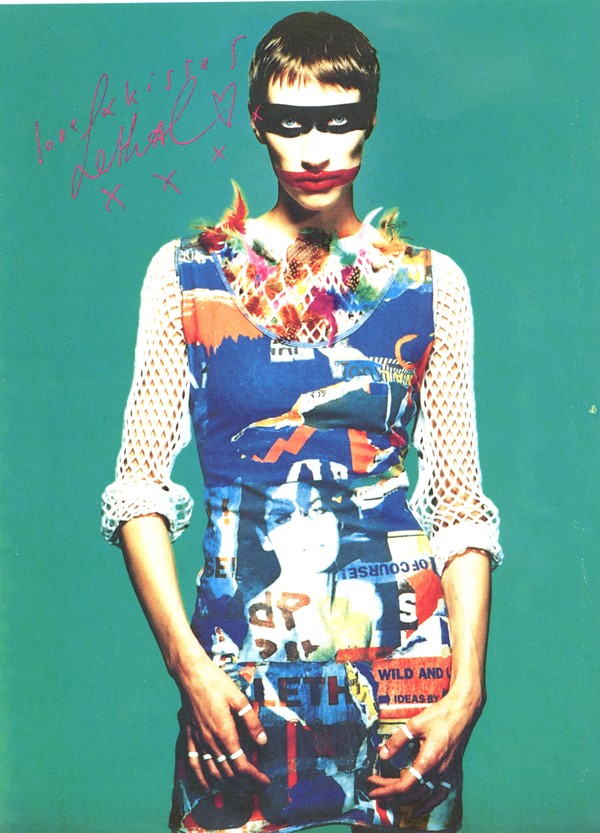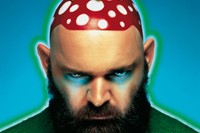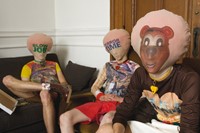Ahead of his first retrospective opening at Antwerp's Fashion Museum next month, Walter Van Beirendonck speaks to AnOther about the curation process, the difference between Antwerp and London and the future of fashion...
Walter Van Beirendonck is without a doubt Belgium’s most recognisable fashion designer. Shortly after his graduation in 1980, he captured the fashion world’s attention as one of the infamous Antwerp Six. In the 1990s, Van Beirendonck’s acclaimed catwalk shows in Paris for his W. & L.T. label cemented his maverick status. In the past decade, he has continued to reinvent the cliched concepts of popular culture in the form of fashion that quite literally spreads the word – he explicitly titles his collections and spells his messages out in slogans on garments. Van Beirendonck’s fashion shows can be regarded as walking political statements, but deciphering Van Beirendonck’s back catalogue is a surprisingly multi-layered experience. There lies a complexity of imagination beneath his apparently evident imagery, which he has consciously simplified for the sake of communication. He pushes social boundaries with a colourful and playful aesthetic. An exhibition in Antwerp’s Fashion Museum, Dream the World Awake which opens next month, is his first large-scale solo retrospective, celebrating three decades’ worth of Van Beirendonck’s work. Here, in a phone call from Antwerp he converses about the exhibition, reflects on his career and puts the future of fashion into perspective.
After three decades, where do you keep finding the energy to express such an unwavering optimism in your work?
I believe in my work and I love what I do. My energy doesn’t wear off as the years pass. Every time I start to work on a new collection I’m happy to be able to put something on paper and then execute it. Every collection is a challenge and the fascination simply stays.
How did the exhibition come about?
I was invited by MoMu (Antwerp’s Fashion Museum). They were aware of my large, personal archive and they also have a lot of pieces in their possession. I very gratefully accepted as it’s a wonderful opportunity and really stimulating to work on such a project which revolves around my body of work. I devised the concept and then worked closely with Kaat Debo of MoMu and Geert Bruloot. Geert previously worked on the Stephen Jones exhibition and acted as a sounding board for the execution of the exhibition. It very much a collaborative effort.
How is the exhibition arranged?
I didn’t think it was good idea to approach my work chronologically. We worked around six themes grouping together concepts. Upon entering it starts with the 'Fairy Tales’ because the narrative dimension has always been important for me. ‘Alien Spirits’ is the next group and references my interest for all things alien but also the spiritual like shamanism. The next group ‘Technocraft’ focuses on a contrast very present in my work; that between the experiment with plastic and synthetic materials alongside with artisanal and embroidery techniques. The second part of the exhibition opens with ‘Alterations’ and covers everything that has inspired me in terms of body culture, tattoos, scarification and plastic surgery. ‘Rituals’ addresses rituals in general but also in relation to tribes, both social and ethnic. And finally the thematic group ‘Action/Reaction’ shows the concerns and commitments apparent in my collections. All silhouettes are taken from the period spanning from my graduation collection of 1980 until now.
Was it difficult to edit your work?
It was a hard process that took months. First of all, there are certain silhouettes in your head, which you feel you must include, but then certain elements that are necessary to complete the silhouette, like shoes or accessories turn out to be missing. It happened a few times, which was such a shame and not easy to digest but all in all I composed 100 silhouettes. It was brilliant to find out that, after years of being stored away in boxes, my work turns out to really have a strong signature. We also made a selection of two projects that are highlighted in the exhibition. One showcases the costumes I created for U2’s PopMart tour in 1997. This was a one-off project that suited my aesthetic at the time seamlessly. The documentary will be screened alongside my sketches and some silhouettes that didn’t make it to the stage. The second project is the collaboration I did with SHOWstudio.com – a shoot photographed by Nick Knight, styled by Simon Foxton. Simon selected from my archive and used a dynamic group of models. The shoot was live-streamed and the result is a monumental photograph measuring 24 metres by 2 metres, which now is on display in the exhibition space. There will also be a wall illustrating my inspirations and way of working.
Does staging your work in a museum entail that you conceive your designs as art?
No. The exhibition is truly meant as a retrospective. I’m showing my inspirations and what comes forth from them. Clothing is to me something to sell and to wear – that is its function. Of course you can tell stories and communicate with fashion, and that is something I definitely try to do in my collections. But essentially it’s a consumer product.
In retrospect, is there anything you would have done differently in your career?
You can never turn back the clock. Ultimately, I am proud that over the course of all these years I’ve persisted and never gave in to commercial pressure. I never made banal or cut-rate adaptations to make more money or sell more. I’m happy that’s the path I’ve taken.
What influence do you hope you’ve had?
It’s quite vain to think of myself in that way, but I do hope to have contributed in some way to the evolution of men’s fashion because that’s what I’ve devoted myself to the most. I always enjoyed pushing its limits. How I’ve influenced it is not a tangible thing but I hope to have made an impact.
London played a pivotal role in the emergence of the Antwerp Six. How important is the city for you now?
I think London is still an incredibly enjoyable city, but when we (the Antwerp Six) first went it was a very conscious decision because London was so energetic. Body Map comes to mind, Leigh Bowery and that whole New Romantic period and Punk. It was such a lively atmosphere at the time. Unfortunately, I don’t feel the same energy in the London fashion scene now. I truly hope young people turn London into a lively city again.
How does Antwerp compare?
Well, I’m definitely not bashing London. Antwerp’s also not the absolute place to be for me. Of course you have the Academy here, and a lot of designers who live and work here, but that doesn’t necessarily mean it’s very energetic either. I think Paris is more vivacious at the moment. In the end, I don’t believe it is determined by cities anymore. New York is just as interesting but there is no one city that sets the tone. It’s much more a matter of what young people are doing, the music that’s on Facebook, theatre and performance. It’s a global happening where everyone is always in transit and the feeling of community is completely different.
The exhibition runs until the beginning of 2012. This is when the Maya prediction you referenced in your Hand on Heart A/W11 collection is supposed to come true. How do you hope the fashion world’s future turns out?
My A/W11 collection’s message was indeed that “Something big is coming”. I do believe we’re at a pivotal point in history. So many things are happening. Not just in fashion but in general. You can sense the tension building up with all the environmental disasters and social aggression. 2012 can be the time to re-evaluate things. You can choose to ignore the Maya prediction – but it’s undeniable that the world is in transformation.
Walter Van Beirendonck – Dream The World Awake runs at Antwerp's Fashion Museum from September 14 until February 19 2011.



